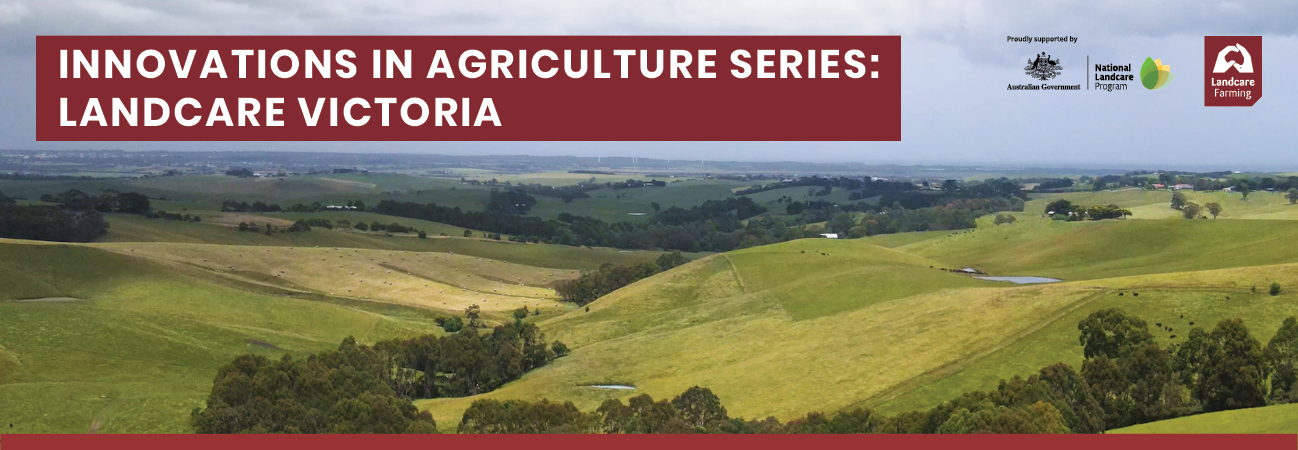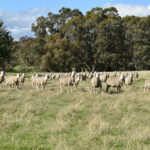
Combined business and biodiversity benefits result from transformative whole farm plan
Under their new whole farm plan, Michael Greene and his family have improved productivity and profitability on their 445ha merino sheep and cattle enterprise ‘Karringal’, all while maintaining their lifelong passion for landcare.
Michael and his brothers began farming in Elmhurst, Victoria, in the mid-sixties. Inspired by their father who won the 1956 Hanslow Cup for Soil Conservation for his water retention works to mitigate erosion (including contour furrowing, diversion banks and tree plantings) and efforts to improve vegetation coverage on hill country by improving pasture, they took a conservation-focused approach to agriculture.
After forming a partnership with his brother John in 1977, Michael continued to build on his on-farm conservation activities, engaging in revegetation and gully erosion mitigation works, as well as improving pasture production. This led the brothers to win the Hanslow Cup for a second time in 1983, this time for hill country fencing, access roading, rehabilitation of gully lines, water and fodder conservation, and sound drought land management.
Today, Michael runs ‘Karringal’ alongside his son Simon, and together they have implemented a whole farm plan, allowing them greater control over stock management and helping to protect the soil from wind and rain erosion as well as overstocking.
“We reorganized the farm so that fencing and paddocks were more suitable to the landscape,” said Michael. “This means fencing done with considering the soil type and natural topography – hill country was fenced out from the lower country, based on slope and aspect. This gave greater control over stock grazing, enabling us to avoid overgrazing and sheep camps.”
Michael fenced the lower country to take in the natural water flow lines, and strategically fenced off gullies from stock to protect banks from erosion. He also fenced off secondary creeks and the Wimmera River, created laneways to make management of the farm easier, and implemented rotational grazing instead of set stocking to improve pasture and soil quality. Preventing overgrazing helped them to reduce water runoff, soil erosion and depleting pastures, including perennial species such as Phalaris (Phalaris sp.), Cocksfoot (Dactylis glomerata), and Fescue (Festuca sp.), as well as biennial Rye-grass (Lolium) and other fodder crops.
“Soil testing has been done over time, to measure pH levels, nutrient and trace element levels, as well as soil organic matter,” said Michael. “Soil testing continues as a means of monitoring pasture production. Looking after the soil is paramount to our farm production.”
The improvements in soil quality pasture production resulting from these works have also been supported by Michael practicing minimum tillage and/or direct seeding for both crop and pasture establishment. Michael explained that they now retain dry grass and stubble from crops where possible, to increase the biomass of the soil.
“The stubble rots down into the soil and builds up the organic matter. Where we crop, we try and retain all of the stubble,” said Michael.
Moving from the practice of set stocking to a rotational grazing system means that more pasture can be left on paddocks, helping to reduce water runoff, and meaning that the soil is less exposed to wind and rain erosion.
Now that the wool industry is actively encouraging farmers to improve biodiversity as part of their operations through the Australian Sheep Sustainability Framework, Michael has also implemented a biodiversity management plan on Karringal which has helped him to attract a price premium for his wool. With consumers increasingly looking for brands to have biodiversity measures in place, Michael has found a number of brands are willing to pay an additional premium for wool certified from a regenerative land management system.
As part of the plan, Michael previously completed eight kilometres* of riparian fencing and revegetation along the Wimmera River, and installed a gully dam at the top of the farm, to ensure his stock still had water access. Prior to the fencing he was able to observe erosion of stream banks into the water, pollution of the water by stock excrement, and depletion of vegetation was having a negative impact on water quality now, the water and river surrounds are visibly healthier with improved biodiversity.
“This was a significant improvement for water and stock management, and provides us with a much more reliable water supply,” said Michael.
Michael’s efforts to improve biodiversity extend beyond the boundaries of his own property. As a founding member and current board member of Project Platypus, a community-based Landcare network working in the Upper Wimmera Catchment, he previously used Karringal to host some of the Network’s first land rehabilitation projects including erosion control works and tree plantings. Now the Greenes are involved in the Grampians to Pyrenees Biolink Project, which aims create biolinks (wildlife corridors) between remnant patches of vegetation, ultimately connecting the Grampians to the Pyrenees ranges and allowing native animals to move across the landscape.
“The Grampians to Pyrenees Biolink project provides us with a great opportunity to enhance these connections,” said Michael. “Our farm borders Mount Cole State Forest, so we are hoping to create vegetation corridors from Mount Cole, down the ridgelines to the flats and connect into the riparian revegetation zones along minor creeks and the Wimmera.”
Launched in 2008, the Grampians to Pyrenees Biolink Project began as a partnership between the Wimmera Catchment Management Austhority, Project Platypus and landholders in the Upper Wimmera Catchment. This later expanded into a wider project team including Gleneg Hopkins Catchment Management Authority, Trust for Nature and Parks Victoria who ran a three-year project to develop a comprehensive biolinks strategy. The strategy mapped ecological assets and identified 11 priority linkage zones including the Upper Wimmera Corridor where Michael’s property is located.
Since the plan was formed, nine years of revegetation works have been undertaken including community planting events involving landholders from over 50 sites. More works are planned to be undertaken, but Michael couldn’t be happier with the results so far.
“I would like to leave land in better condition for the next generation. I think I can depart this world knowing that I have done that,” said Michael.
* Large-scale flooding events in 2022 unfortunately resulted in the majority of Michael’s riparian fencing being substantially damaged by flooding, however work has now been completed on replacing these fence lines.
This case study was produced as part of the Landcare Farming Innovations in Agriculture Series. Supported by the Australian Government’s National Landcare Program, the Landcare Farming Innovations in Agriculture Series is managed in partnership by Landcare Australia and the National Landcare Network.
Explore the following resources to find out more:







